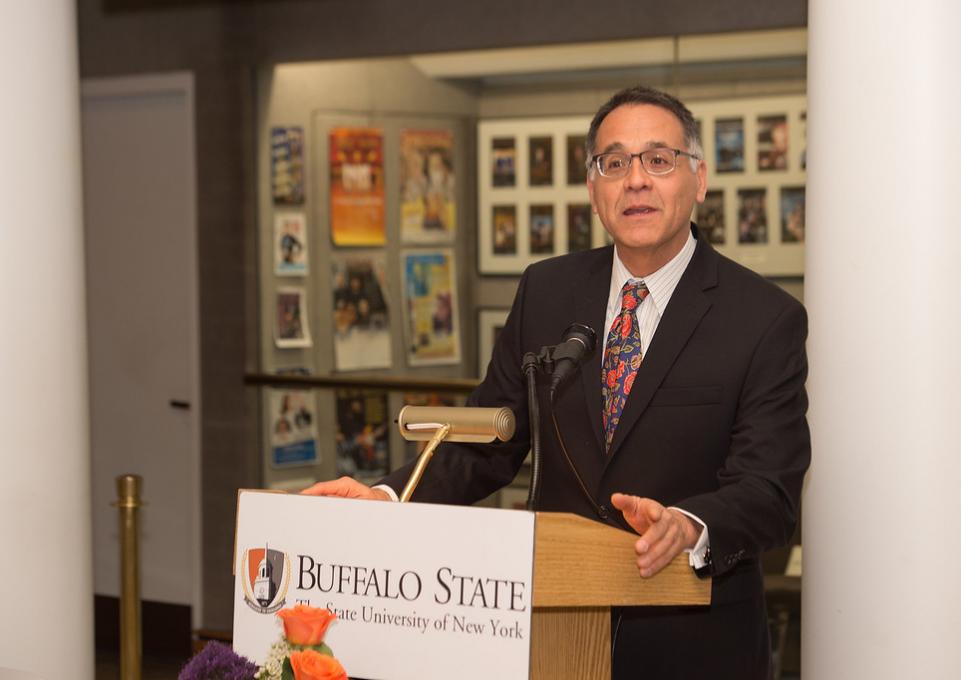
Growing up in Lima, Peru, Patrick Ravines, Buffalo Sate associate professor and director of art conservation, spent hours surfing in the Pacific Ocean. Reveling in the ebb and flow of the waves, he was fascinated with what life lay beneath.
This passion led him to the University of Washington, Seattle, where he studied oceanography as an undergraduate and majored in chemistry. It was his second major, one he pursued as a graduate student at the University of Wisconsin at Milwaukee, that ultimately led to a career immersed in the conservation of rare books, photographs, and historic art rather than sea life.
Ravines learned early on that he could marry his affinity for chemistry with his love of historic art objects. Both are required for the unique career of an art conservator.
“My parents loved books and always had a variety of rare books,” he said, adding that photography was an early hobby that he still dabbles in today. “When I discovered I could restore books, historic papers, and photographs as a career, I pursued it.”
Indeed. After studying the conservation of rare books and archival materials at Columbia University, Ravines has devoted more than 30 years to the profession—culminating in his being selected director of the Buffalo State art conservation program in 2010, the fourth director since its inception in Cooperstown, New York, in 1970.
Prior to this position, he spent more than a decade in Haifa, Israel, serving as the chief of a new conservation office for the Bahá'í World Centre. He and his family of five then moved to Rochester, New York, when he was named an Andrew W. Mellon fellow and then senior research fellow and project conservator with the George Eastman House of International Photography and Film.
During that time, he regularly visited the art conservation open houses, conferences, and workshops at Buffalo State. Now he hosts those events. He also is charged with hiring faculty, recruiting students, and raising money.
He arrived at Buffalo State at an auspicious time. Since he joined the department, it has received a $2 million challenge grant from the Andrew W. Mellon Foundation, along with numerous other grants and individual gifts. Most remarkably, last year, the Richard E. and Patricia H. Garman family of Western New York awarded a gift of $4 million to the department, the largest one-time gift in the college’s history. On March 31, the department was officially named in honor of the couple.
“Running the department is like running a small business,” Ravines said. Funding fellowships are always top of mind, as is luring the best and the brightest students for each fall class of 10.
The good news is that employment outlooks are strong for this profession. According to the Bureau of Labor Statistics, jobs for art conservators and museum technicians were predicted to grow by 26 percent between 2008 and 2018. However, it takes a special person to be the right fit.
“Students will be working with priceless collections in institutions and with private collectors,” he said. “Like a dentist, you want someone with a steady hand and a skilled mind. We want candidates who are bright, who also have manual skills and are good problem-solvers. Art conservators have to have the ability to think on their feet and get along with a wide range of people.”
Ravines cannot imagine doing anything else. Much as he once contemplated the mysteries of the sea, he continues to revel in examining art, papers, photographs, and books ravaged by time to find the beauty that lies beneath.
About Patrick Ravines
Ravines holds a bachelor’s degree in chemistry from the University of Washington, Seattle, and master’s degree in chemistry from the University of Wisconsin, Milwaukee. He also holds a master’s degree in library science and a certificate in library and archives conservation from Columbia University. His areas of expertise include research on nineteenth-century photographic processes, namely daguerreotypes and platinotypes.
